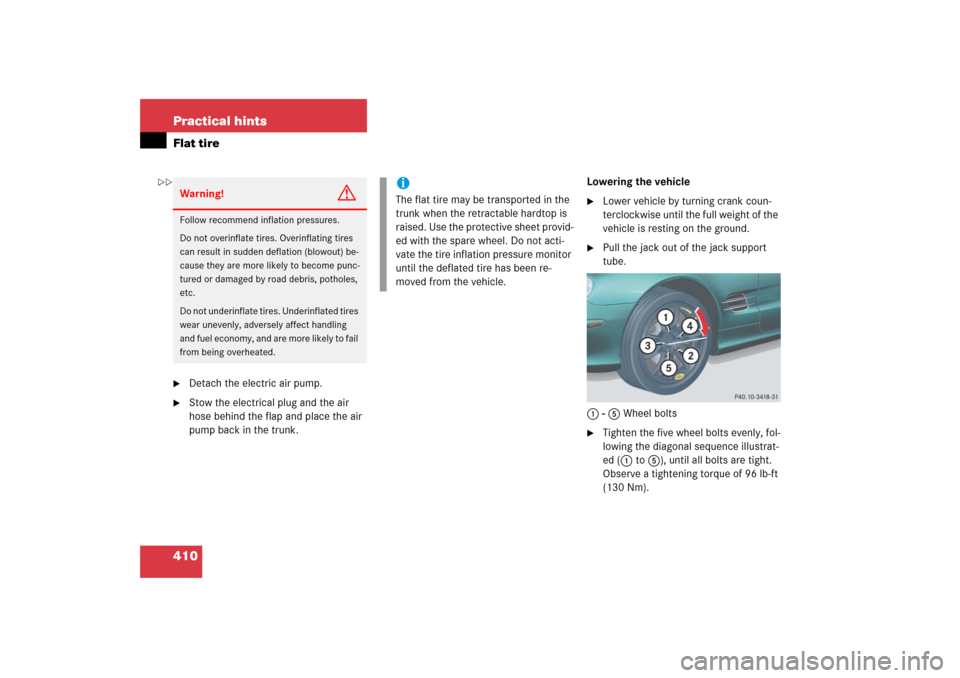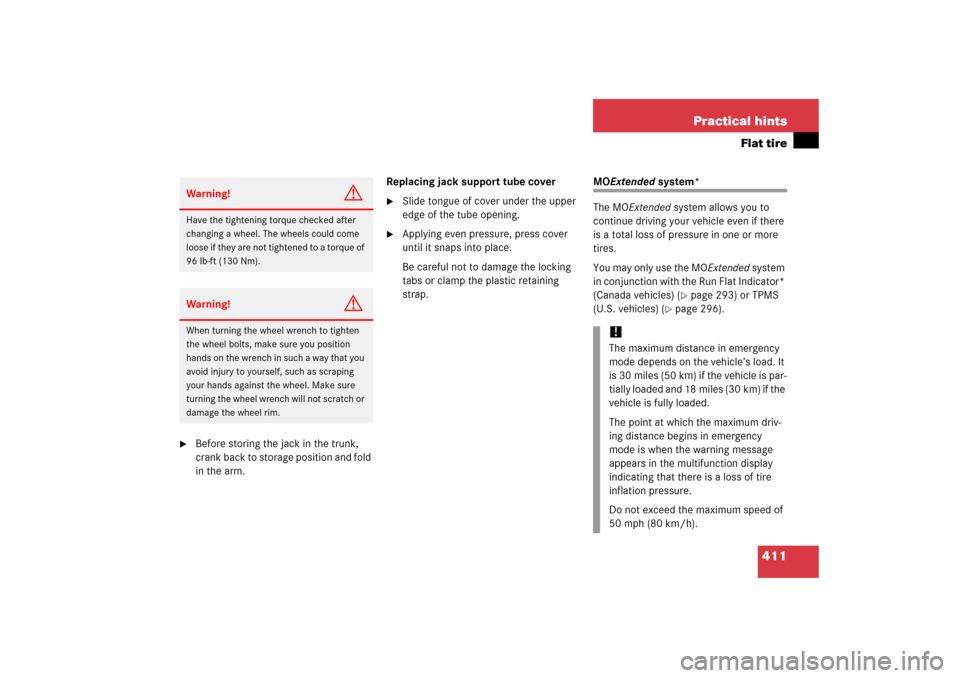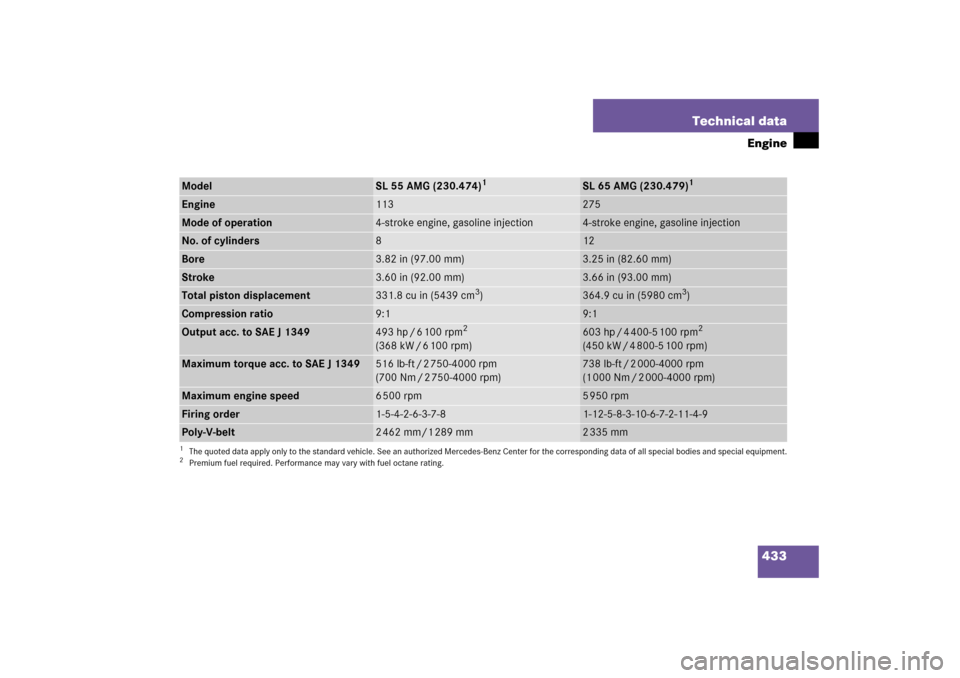Page 315 of 480
314 OperationTires and wheelsFor information on wheel change, see the
“Practical hints” section (
�page 383) and
(
�page 399).Warning!
G
Have the tightening torque checked after
changing a wheel. Wheels could become
loose if not tightened with a torque of
96 lb-ft (130 Nm).
Only use genuine Mercedes-Benz wheel
bolts specified for your vehicle’s rims.
Page 411 of 480

410 Practical hintsFlat tire�
Detach the electric air pump.
�
Stow the electrical plug and the air
hose behind the flap and place the air
pump back in the trunk.Lowering the vehicle
�
Lower vehicle by turning crank coun-
terclockwise until the full weight of the
vehicle is resting on the ground.
�
Pull the jack out of the jack support
tube.
1 - 5 Wheel bolts
�
Tighten the five wheel bolts evenly, fol-
lowing the diagonal sequence illustrat-
ed (1 to 5), until all bolts are tight.
Observe a tightening torque of 96 lb-ft
(130 Nm).
Warning!
G
Follow recommend inflation pressures.
Do not overinflate tires. Overinflating tires
can result in sudden deflation (blowout) be-
cause they are more likely to become punc-
tured or damaged by road debris, potholes,
etc.
Do not underinflate tires. Underinflated tires
wear unevenly, adversely affect handling
and fuel economy, and are more likely to fail
from being overheated.
iThe flat tire may be transported in the
trunk when the retractable hardtop is
raised. Use the protective sheet provid-
ed with the spare wheel. Do not acti-
vate the tire inflation pressure monitor
until the deflated tire has been re-
moved from the vehicle.
��
Page 412 of 480

411 Practical hints
Flat tire
�
Before storing the jack in the trunk,
crank back to storage position and fold
in the arm.Replacing jack support tube cover
�
Slide tongue of cover under the upper
edge of the tube opening.
�
Applying even pressure, press cover
until it snaps into place.
Be careful not to damage the locking
tabs or clamp the plastic retaining
strap.
MOExtended system*
The MOExtended system allows you to
continue driving your vehicle even if there
is a total loss of pressure in one or more
tires.
You may only use the MOExtended system
in conjunction with the Run Flat Indicator*
(Canada vehicles) (
�page 293) or TPMS
(U.S. vehicles) (
�page 296).
Warning!
G
Have the tightening torque checked after
changing a wheel. The wheels could come
loose if they are not tightened to a torque of
96 lb-ft (130 Nm).Warning!
G
When turning the wheel wrench to tighten
the wheel bolts, make sure you position
hands on the wrench in such a way that you
avoid injury to yourself, such as scraping
your hands against the wheel. Make sure
turning the wheel wrench will not scratch or
damage the wheel rim.
!The maximum distance in emergency
mode depends on the vehicle’s load. It
is 30 miles (50 km) if the vehicle is par-
tially loaded and 18 miles (30 km) if the
vehicle is fully loaded.
The point at which the maximum driv-
ing distance begins in emergency
mode is when the warning message
appears in the multifunction display
indicating that there is a loss of tire
inflation pressure.
Do not exceed the maximum speed of
50 mph (80 km/h).
Page 433 of 480
432 Technical dataEngineModel
SL 500 (230.475)
1
1The quoted data apply only to the standard vehicle. See an authorized Mercedes-Benz Center for the corresponding data of all special bodies and special equipment.
SL 600 (230.476)
1
Engine
113
275
Mode of operation
4-stroke engine, gasoline injection
4-stroke engine, gasoline injection
No. of cylinders
8
12
Bore
3.82 in (97.00 mm)
3.23 in (82.00 mm)
Stroke
3.31 in (84.00 mm)
3.43 in (87.00 mm)
Total piston displacement
303.0 cu in (4966 cm
3)
336.4 cu in (5 513 cm
3)
Compression ratio
10:1
9:1
Output acc. to SAE J 1349
302 hp / 5 600 rpm
2
(225 kW / 5 600 rpm)
2Premium fuel required. Performance may vary with fuel octane rating.
493 hp /5 000 rpm
2
(368 kW / 5 000 rpm)
Maximum torque acc. to SAE J 1349
339 lb-ft / 2 700 rpm
(460 Nm / 2700 - 4 250 rpm)
590 lb-ft /3 500 rpm
(800 Nm /1 800 - 3 500 rpm)
Maximum engine speed
6300 rpm
5950 rpm
Firing order
1-5-4-2-6-3-7-8
1-12-5-8-3-10-6-7-2-11-4-9
Poly-V-belt
2390 mm
2332 mm
Page 434 of 480

433 Technical data
Engine
Model
SL 55 AMG (230.474)
1
1The quoted data apply only to the standard vehicle. See an authorized Mercedes-Benz Center for the corresponding data of all special bodies and special equipment.
SL 65 AMG (230.479)
1
Engine
113
275
Mode of operation
4-stroke engine, gasoline injection
4-stroke engine, gasoline injection
No. of cylinders
8
12
Bore
3.82 in (97.00 mm)
3.25 in (82.60 mm)
Stroke
3.60 in (92.00 mm)
3.66 in (93.00 mm)
Total piston displacement
331.8 cu in (5439 cm
3)
364.9 cu in (5980 cm
3)
Compression ratio
9:1
9:1
Output acc. to SAE J 1349
493 hp / 6 100 rpm
2
(368 kW / 6 100 rpm)
2Premium fuel required. Performance may vary with fuel octane rating.
603 hp / 4 400-5 100 rpm
2
(450 kW / 4 800-5 100 rpm)
Maximum torque acc. to SAE J 1349
516 lb-ft / 2 750-4000 rpm
(700 Nm / 2 750-4000 rpm)
738 lb-ft / 2 000-4000 rpm
(1 000 Nm / 2 000-4000 rpm)
Maximum engine speed
6 500 rpm
5 950 rpm
Firing order
1-5-4-2-6-3-7-8
1-12-5-8-3-10-6-7-2-11-4-9
Poly-V-belt
2 462 mm/1 289 mm
2 335 mm
Page 443 of 480
442 Technical dataElectrical systemModel
SL 500
SL 600
SL 55 AMG
SL 65 AMG
Generator (alternator)
14 V/150 A
14 V/180 A
14 V/180 A
14 V/180 A
Starter motor
12 V/1.7 kW
12 V/1.7 kW
12 V/1.7 kW
12 V/1.7 kW
BatteryStarter battery
12 V/35 Ah
12 V/35 Ah
12 V/35 Ah
12 V/35 Ah
Battery for electrical consumers
12 V/70 Ah
12 V/70 Ah
12 V/70 Ah
12 V/70 Ah
Spark plugs
Bosch F 8 DPP 33
NGK PFR5R11
NGK IFR6QG
NGK ILFR6A
NGK IFR6QG
Electrode gap
0.039 in (1.0 mm)
0.028 in (0.7 mm)
0.031 in (0.8 mm)
0.028 in (0.7 mm)
Tightening torque
15 – 22 lb-ft
(20 – 30 Nm)
18 – 22 lb-ft
(25 – 30 Nm)
18 – 22 lb-ft
(25 – 30 Nm)
18 – 22 lb-ft
(25 – 30 Nm)
Page 458 of 480

457 Technical terms
Overspeed range
Engine speeds within the red marking
on the tachometer dial, see “Tachome-
ter” (
�page 133). Avoid this engine
speed range, as it may result in serious
engine damage that is not covered by
the Mercedes-Benz Limited Warranty.
Parktronic (Parking assist)*
System which uses visual and acoustic
signals to assist the driver during park-
ing maneuvers.
Poly-V-belt drive
Drives engine-components (alternator,
AC compressor, etc.) from the engine.Power train
Collective term designating all compo-
nents used to generate and transmit
motive power to the drive axles, includ-
ing
�
engine
�
clutch/torque converter
�
transmission
�
transfer case
�
drive shaft
�
differential
�
axle shafts/axles
Production options weight
(
�page 311)Program mode selector switch
Used to switch the automatic transmis-
sion between standard operation (S)
and comfort operation (C).
SL 55 AMG with steering wheel gear-
shift control and manual shift program:
In addition to S and C (for regular S or
comfort C operation, see above), you
can use MANUAL for manual shift pro-
gram.
PSI
(P
ounds p
er s
quare i
nch)
(
�page 312)
Recommended tire inflation pressure
(�page 312)
REST
(Residual Engine Heat Utilization)
Feature that uses the engine heat
stored in the coolant to heat the vehi-
cle interior for a short time after the en-
gine has been turned off.
Page 459 of 480

458 Technical termsRetractable hardtop
Hardtop roof that can be opened and
closed at the push of a button and
stored in the trunk.
Rim
(
�page 312)
Roll bar
Occupant protection system which
consists of tubular steel sheathed in
plastic. The roll bar is lowered into the
car body during normal driving condi-
tions and raised automatically. It may
also be manually raised and lowered by
operating a button during critical driv-
ing situations.
RON
The Research Octane Number for gaso-
line as determined by a standardized
method. It is an indication of a gaso-
line’s ability to resist undesired detona-
tion (knocking). The average of both
the MON (Motor Octane Number) and
RON (Research Octane Number) is
posted at the pump, also known as
ANTI-KNOCK INDEX.Shift lock
When the vehicle is parked, this lock
prevents the gear selector lever from
being inadvertently moved out of posi-
tion P without SmartKey turned and
brake pedal depressed.
Sidewall
(
�page 312)
SRS
(Supplemental R
estraint S
ystem)
Seat belts, emergency tensioning de-
vice and airbags. Though independent
systems, they are closely interfaced to
provide effective occupant protection.Tele Aid System
(Tele
matic A
larm I
dentification on D
e-
mand)
The Tele Aid system consists of three
types of response: automatic and man-
ual emergency, roadside assistance
and information. Tele Aid is initially ac-
tivated by completing a subscriber
agreement and placing an acquain-
tance call.
The Tele Aid system is operational pro-
vided that the vehicle’s battery is
charged, properly connected, not dam-
aged and cellular and GPS coverage is
available.
Tightening torque
Force times lever arm (e.g. a lug
wrench) with which threaded fasteners
such as wheel bolts are tightened.
TIN
(T
ire I
dentification N
umber)
(
�page 312)
Tire load rating
(�page 312)